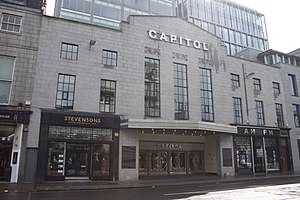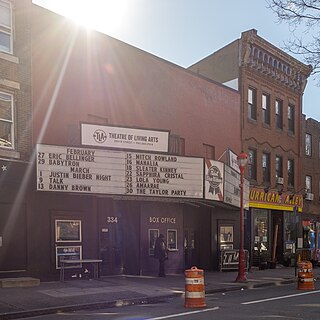
The Theatre of Living Arts is a concert venue that is located on South Street in Philadelphia, Pennsylvania. The venue, which opened in 1988, dates back to the early 1900s as a nickelodeon.
The Turra Coo was a white Ayrshire-Shorthorn cross dairy cow which lived near the Aberdeenshire town of Turriff in north-east Scotland in the early twentieth century. The cow became famous following a dispute between her owner, supported by local people, against the government over taxes and compulsory national insurance.
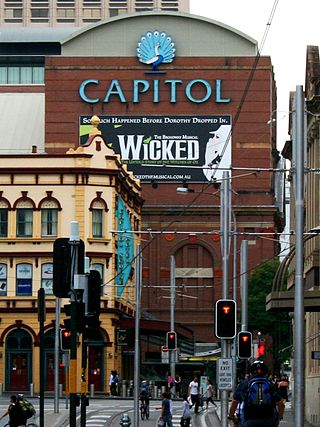
The Capitol Theatre is a heritage-listed theatre located at 3-15 Campbell Street, Haymarket, in the Sydney central business district, Australia. It was designed by Henry Eli White and John Eberson and built from 1893 to 1928. The property was added to the New South Wales State Heritage Register on 2 April 1999. The former circus venue, atmospheric theatre and market venue in owned by Capitol Theatre Management Pty Limited, a wholly owned subsidiary of Foundation Theatres Pty Limited. Foundation Theatres owns the Sydney Lyric and Capitol Theatre.
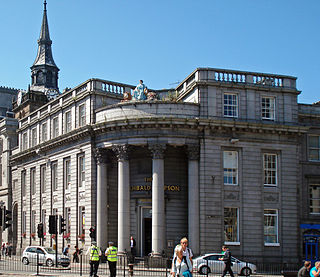
The architecture of Aberdeen, Scotland, is known for the use of granite as the principal construction material. The stone, which has been quarried in and around the city, has given Aberdeen the epithet The Granite City, or more romantically, and less commonly used, the Silver City, after the mica in the stone which sparkles in the sun.

The city of Aberdeen in Scotland has amenities that cover a wide range of cultural activities, including a selection of museums and galleries. There are festivals and theatrical events throughout the year.

The Granville Entertainment District is a neighbourhood in Downtown Vancouver known for its vast assortment of bars, danceclubs, restaurants, nightlife, and urban adult oriented shops and entertainment. The entertainment district centred on a seven-block stretch of the Granville Mall and surrounding streets.
Green's Playhouse was an entertainment complex comprising a cinema, ballroom, tea rooms and other facilities. The Playhouse was at 126 Renfield Street, Glasgow, Scotland, commissioned by George Green Ltd, designed by the architect John Fairweather, and built by the Cinema Building Company. Opened in 1927, the Playhouse operated until the 1970s, a decline in audience numbers in the 1960s necessitated diversification as a music venue until closure in 1973. The building continued in use as the Apollo, after being acquired by Unicorn Leisure on a lease-holding arrangement, until final closure in 1985, with subsequent demolition in 1987.
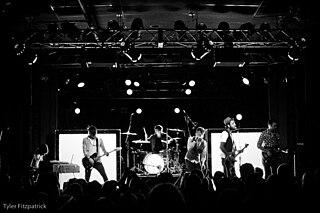
The Recher is a concert venue in Towson, Maryland. It is located at 512 York Road in the building previously operated as the Towson Theatre, a one-screen movie theater. The Towson Theatre was designed by architect John Ahlers of the George Norbury MacKenzie III architectural firm. It cost $100,000 to build and opened on March 1, 1928. The theatre was sold to the Recher family in the 1950s, who continued running the cinema into the 1990s. They then converted it into an upscale billiard parlor. The building was later transformed into The Recher Theatre, a concert venue, which opened in 1999.

Eden Court Theatre is a large theatre, cinema and arts venue situated in Inverness, Scotland close to the banks of the River Ness. The theatre has recently undergone a complete refurbishment and major extension, adding a second theatre, two dedicated cinema screens, two performance/dance studios, improved dressing room and green room facilities and additional office space. The theatre's restaurant and bar facilities have also been totally overhauled and improved.
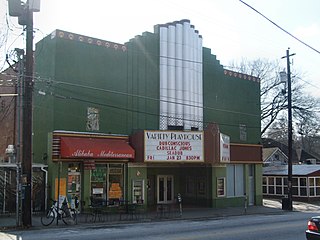
The Variety Playhouse is a music venue in Atlanta, Georgia, United States. It is located on Euclid Avenue and features a variety of music acts including rock, indie, electronic, funk, country, folk, bluegrass, jazz, blues and world music as well as other live shows.
Alexander Marshall MacKenzie was a Scottish architect responsible for prestigious projects including the headquarters of the Isle of Man Banking Company in Douglas, and Australia House and the Waldorf Hotel in London.
Aberdeen has been the host of several theatres and concert halls through history. Some of them have been converted or destroyed over the years.
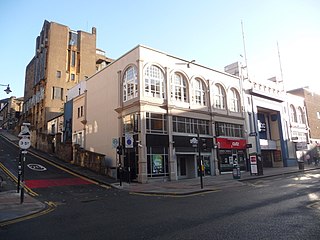
The O2 ABC was a nightclub and music venue on Sauchiehall Street, in the centre of Glasgow. The building was constructed in 1875, renovated many times in its lifetime and also largely rebuilt in the 1920s. The building was used for numerous functions before being finally converted to its final purpose between 2002 and 2005, before finally closing in June 2018 after extensive fire damage. In 2009, the Academy Music Group took a majority stake in the venue, rebranding it the O2 ABC. The venue is protected as a category C(S) listed building. In March 2009; the Academy Music Group became the major stockholder of the O2 ABC.

Paris Theatre, formerly Third Avenue Theatre and also known as Paris Theater or Ray's Paris Theatre, is an historic building in Portland, Oregon's Old Town Chinatown neighborhood, in the United States. The theatre was constructed in 1890 and opened as a burlesque house. It was later converted to a cinema, then a club and music venue, before serving as an adult movie theater until 2016. The building was a live venue and nightclub until it closed in October 2019.

William Paterson, known as William Dove Paterson, or more commonly Dove Paterson was a pioneer of cinema in Aberdeen, Scotland.

Robert Gordon Wilson (1844–1931) was a 19th/20th century Scottish architect based in Aberdeen. He was from a strong United Presbyterian background and specialised in churches for the United Presbyterian Church and Free Church of Scotland.
Thomas Scott Sutherland, known commonly as Tommy Scott Sutherland, or simply Scott Sutherland (1899–1963) was a distinguished architect, city Councillor in Aberdeen, and entrepreneur and benefactor. In the 1950s he gifted Garthdee House to the Gray's School of Architecture at Robert Gordon's College, later the Robert Gordon University. The former was renamed the Scott Sutherland School of Architecture.

The Highland Church was a Gaelic-speaking congregation of the Church of Scotland, based in Tollcross, Edinburgh. Formed by the union of St Oran's Church and St Columba's Gaelic Church in 1948, the congregation continued united with Tolbooth St John's in 1956.
